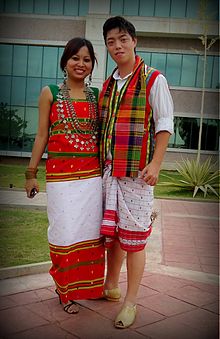Tipra People | |
|---|---|
 Tripuri woman and man in traditional attire | |
| Total population | |
| 1.2 million (2011) | |
| Regions with significant populations | |
| 1,011,294[1] | |
| Tripura | 950,875[1] |
| Mizoram | 32,634[1] |
| Assam | 22,890[1] |
| Meghalaya | 2,735[1] |
| Nagaland | 350[1] |
| Gujarat | 239[1] |
| Manipur | 208[1] |
| Jammu and Kashmir | 190[1] |
| Rajasthan | 169[1] |
| West Bengal | 120[1] |
| Maharashtra | 118[1] |
| Karnataka | 114[1] |
| 156,578 (2021)[2] | |
| Languages | |
| Kokborok (Tripuri) | |
| Religion | |
| Majority Minority | |
| Related ethnic groups | |
| |
The Tripuri (also known as Tripura, Tipra, Twipra, Tipperah) are a Tibeto-Burman-speaking ethnic group of Bangladesh and Northeast Indian state of Tripura.[4][5][6] They are the descendants of the inhabitants of the Twipra/Tripura Kingdom in North-East India and Bangladesh. The Tripuri people through the Manikya dynasty ruled the Kingdom of Tripura for over 600 years starting from 1400 A.D. until the kingdom joined the Indian Union on 15 October 1949.[7] The Tipra Dynasty was established in 590 AD.[citation needed]
- ^ a b c d e f g h i j k l m "Distribution of the 99 Non-Scheduled Languages- India/ States/ Union Territories-2011 Census" (PDF). censusindia.gov.in. pp. 48, 49. Retrieved 10 April 2021.
Look for "92. TRIPURI", total number of Tripuri speakers in India given as 11294 on page 48, then state wise break-up on page 49
- ^ "Table 1.4 Ethnic Population by Group and Sex" (PDF) (in Bengali). Bangladesh Bureau of Statistics. 2021. p. 33.
- ^ "Tripura" (PDF). Office of the Registrar General & Census Commissioner, India.
- ^ Hasan, Nur; Jahan, Rownak (2014). "A survey of medicinal plants used by the Deb barma clan of the Tripura tribe of Moulvibazar district, Bangladesh". Journal of Ethnobiology and Ethnomedicine. 10: 3–19. doi:10.1186/1746-4269-10-19. PMC 3996145. PMID 24502444.
- ^ Ahmed, Sazdik; Ravhee, Shahla (2020). "A Study on the Settlement Morphology of Tipra (Tripura) ethnic group in Sreemangal, Bangladesh". Journal of Recent Activities in Architectural Sciences: 3–19. doi:10.46610/JoRAAS.2020.v05i01.003. S2CID 234648795.
- ^ Barma, Aloy Deb (2024). "Talking Back through Peripheral Visions and Negotiating Identity: Kokborok and Bengali Films and Music Videos in Tripura". Journal of Film and Video. 76 (2): 33–48. doi:10.5406/19346018.76.2.05. ISSN 1934-6018.
- ^ Jain, Anshika (11 June 2019). "Tripura's Ujjayanta: Seat of the Manikyas". Live History India. It rose like a phoenix out of the ashes, quite literally. Situated in the city of Agartala is the exquisite Ujjayanta Palace, home of the Tripura royals and also a state museum. This delicate beauty was built in the late 19th century by Maharaja Radha Kishore Manikya of the Manikya dynasty, after a devastating earthquake flattened Agartala, the capital of Tripura. It went on to become a symbol of a modern phase in the Kingdom of Tripura. You may not have heard of them but the Manikya dynasty of Tripura is one of the oldest continuously reigning dynasties of India. The exact date of its founding is shrouded in legend – the Rajmala, a 15th century chronicle of the kings of Tripura, traces the history of the dynasty to the Mahabharata. But, historically speaking, the dynasty is said to have been founded by Ratna Manikya in 1267 CE. Archived from the original on 29 September 2020. Retrieved 3 April 2021.